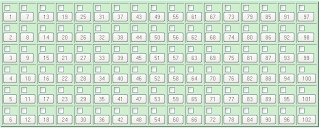Introduction to simple fractions in math:
A fraction is a number that can represent part of a whole. The earliest fractions were reciprocals of integers: ancient symbols representing one part of two, one part of three, etc…A fraction consist of a numerator and a denominator, the numerator representing a number of equal parts and the denominator telling how many of those parts make up a whole.
SOURCE: WIKIPEDIA
Examples problems of simple fractions in math:
Simple math fraction example 1:
Solve `7/4+5/2`
Solution:
We can add the given fractions by using the following methods.
First we can see the denominator part.
If denominator values are same we can not make any change in the numerator.
But if denominator values are different we can find the L.C.M of denominators and then change the numerator value depends on L.C.M value.
In the above problem, denominators are different.
So we can take the L.C.M of 4, 2.
L.C.M (4, 2) = 4
Therefore, `(7*2)/ (4*2) + (5*4)/(2*4)`
`= 14/8+20/8`
Now denominators are equal. Then we can add the fractions easily.
That is, `(14+20)/8`
`= 34/8`
After simplifying,
`= 17/4`
Answer: `17/4`
Simple math fraction example 2:
Solve `9/2- 5/3`
Solution:
We can subtract the given fractions by using the following methods.
Before we can go to subtracting, we can see the denominator part.
If denominator values are equal we need not to change the numerator.
But if denominator values are different we can find the L.C.M of denominators and then change the numerator value depends on L.C.M value.
In the above problem, denominators are different.
So we can take the L.C.M of 2, 3.
L.C.M (2, 3) = 6
Therefore, `(9*3)/(2*3)-(5*2)/(3*2)`
`= 27/6-10/6`
Here denominators are equal.
That is, `(27-10)/6`
`= 17/6`
Answer: `17/6`
Simple math fraction example 3:
Solve `1/2* 3/2`
Solution:
We can multiply the given fractions by using the following method.
Fractions are multiply by the multiplication of both numerators and also both denominators.
That is, `(1*3)/ (2*2)`
` = 3/4`
Answer: `3/4`
Practice problems of simple fractions in math:
Simple math problems:
Solve `9/2+ 4/3 `
Solve `3/4-1/2 `
Solve `6/2*7/3`
Answer:
`35/6`
`1/4`
`7`
A fraction is a number that can represent part of a whole. The earliest fractions were reciprocals of integers: ancient symbols representing one part of two, one part of three, etc…A fraction consist of a numerator and a denominator, the numerator representing a number of equal parts and the denominator telling how many of those parts make up a whole.
SOURCE: WIKIPEDIA
Examples problems of simple fractions in math:
Simple math fraction example 1:
Solve `7/4+5/2`
Solution:
We can add the given fractions by using the following methods.
First we can see the denominator part.
If denominator values are same we can not make any change in the numerator.
But if denominator values are different we can find the L.C.M of denominators and then change the numerator value depends on L.C.M value.
In the above problem, denominators are different.
So we can take the L.C.M of 4, 2.
L.C.M (4, 2) = 4
Therefore, `(7*2)/ (4*2) + (5*4)/(2*4)`
`= 14/8+20/8`
Now denominators are equal. Then we can add the fractions easily.
That is, `(14+20)/8`
`= 34/8`
After simplifying,
`= 17/4`
Answer: `17/4`
Simple math fraction example 2:
Solve `9/2- 5/3`
Solution:
We can subtract the given fractions by using the following methods.
Before we can go to subtracting, we can see the denominator part.
If denominator values are equal we need not to change the numerator.
But if denominator values are different we can find the L.C.M of denominators and then change the numerator value depends on L.C.M value.
In the above problem, denominators are different.
So we can take the L.C.M of 2, 3.
L.C.M (2, 3) = 6
Therefore, `(9*3)/(2*3)-(5*2)/(3*2)`
`= 27/6-10/6`
Here denominators are equal.
That is, `(27-10)/6`
`= 17/6`
Answer: `17/6`
Simple math fraction example 3:
Solve `1/2* 3/2`
Solution:
We can multiply the given fractions by using the following method.
Fractions are multiply by the multiplication of both numerators and also both denominators.
That is, `(1*3)/ (2*2)`
` = 3/4`
Answer: `3/4`
Practice problems of simple fractions in math:
Simple math problems:
Solve `9/2+ 4/3 `
Solve `3/4-1/2 `
Solve `6/2*7/3`
Answer:
`35/6`
`1/4`
`7`
